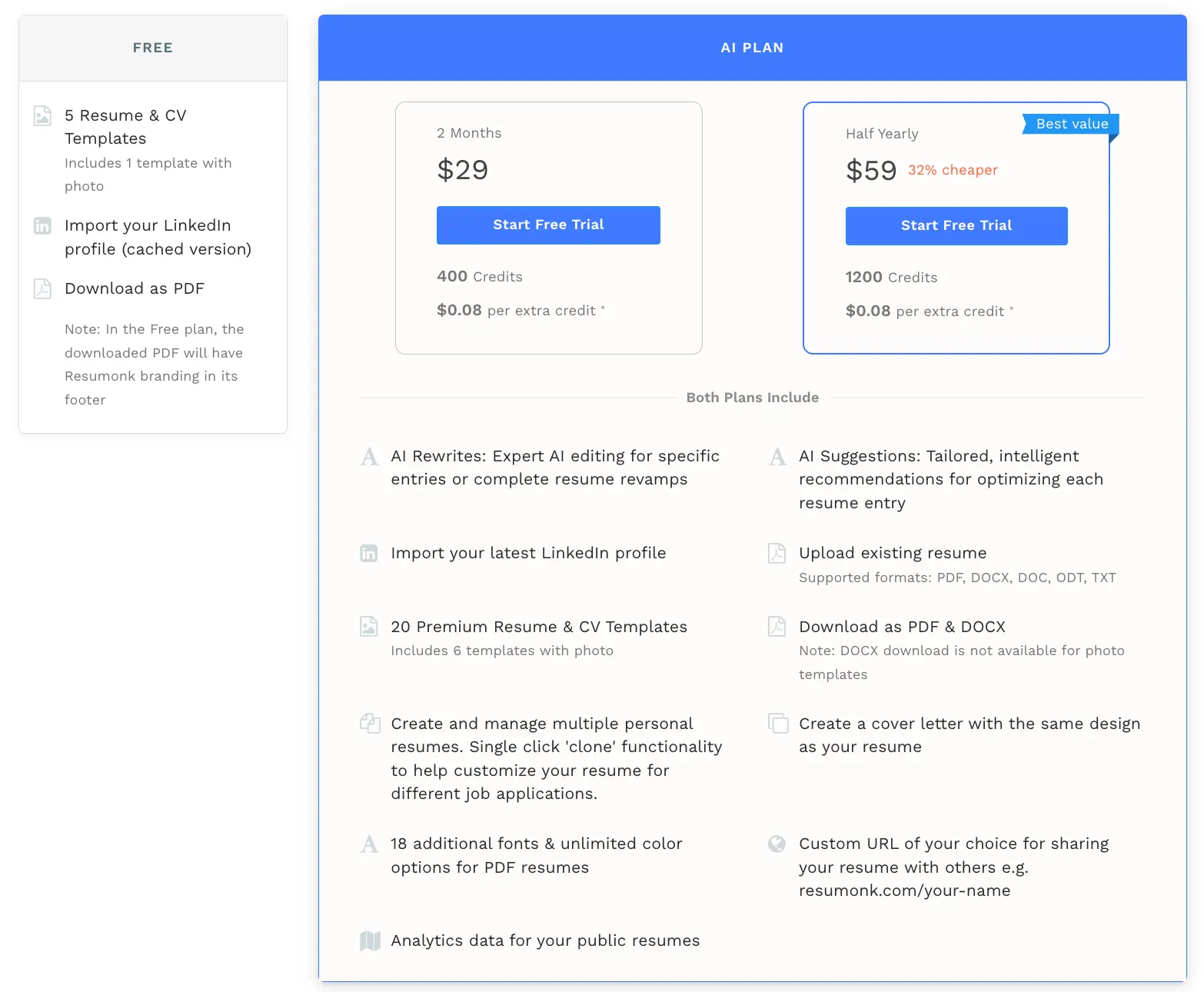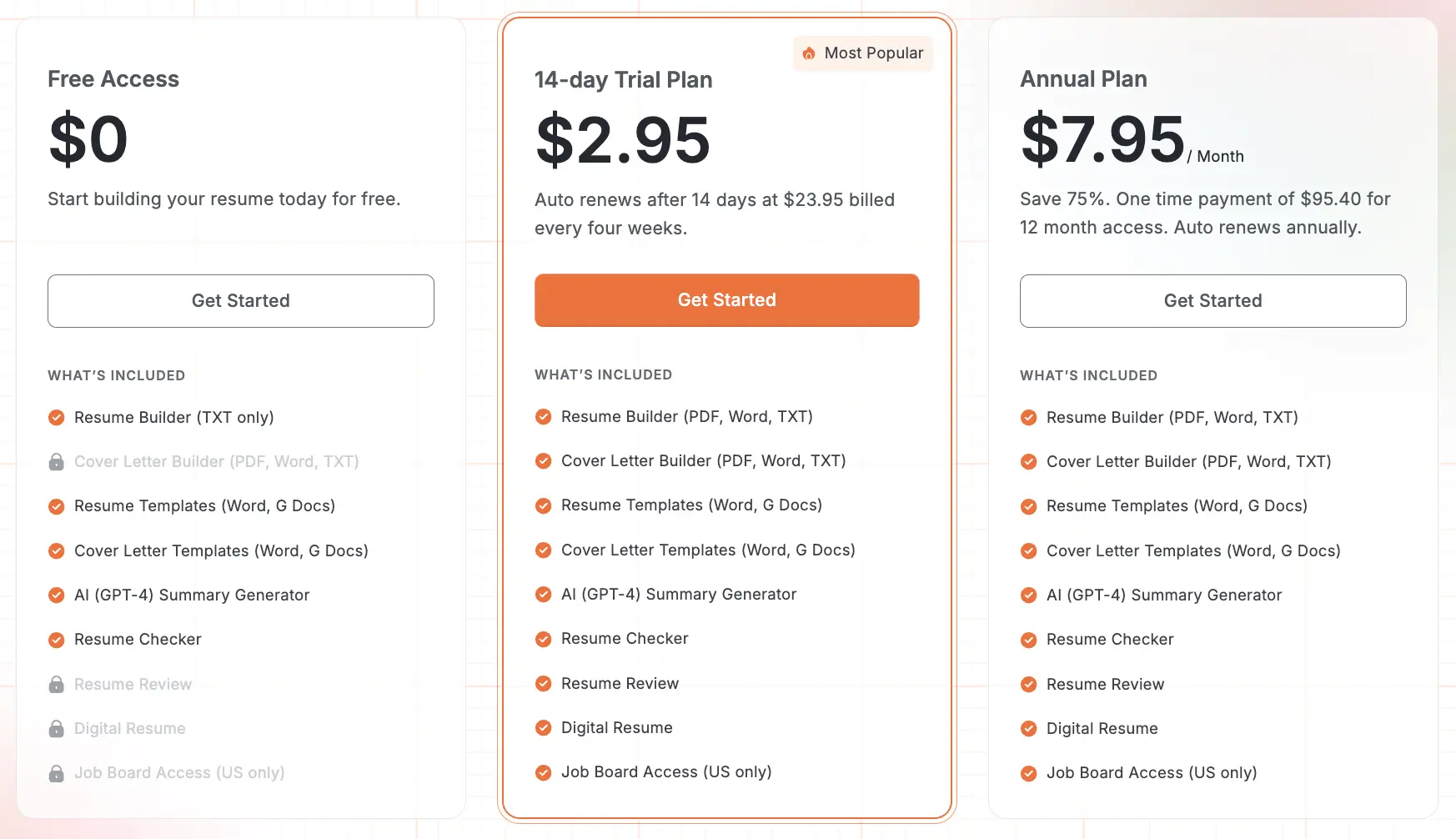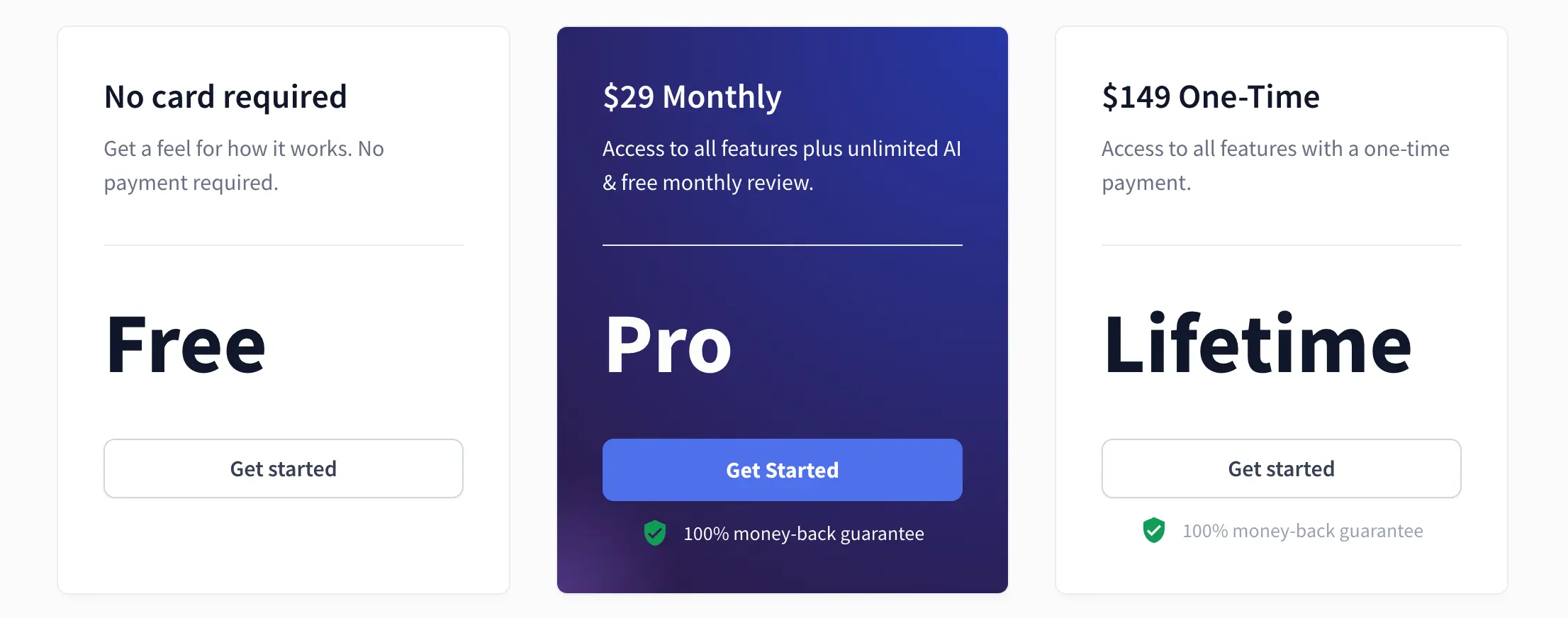
Searching for a "Zety alternative" usually means one thing: you want the convenience of an online resume builder but you’re weighing trade-offs - price, templates, writing help and how much control you keep over the final file.
As a team that builds resume tools every day, we know job seekers want a product that gets them from blank page to interview-ready document without surprises. In this guide we walk through the options, explain the criteria that matter, and give clear, practical comparisons so you can pick the best fit for your stage and budget.
How we think about a “great” resume builder: it needs to be easy to start with (LinkedIn import and sensible prompts), give you templates that fit your industry and level, offer writing help when you want it, export in formats hiring teams expect, and show pricing that’s straightforward.
Those categories - usability, design, AI/writing support, import/export, and pricing transparency - are the framework we used to evaluate every tool below.
We curated alternatives by combining product documentation, up-to-date vendor pricing pages and customer feedback on review platforms, then evaluated each tool against the five core criteria above.
Wherever possible we double-checked vendor pages for the latest plans and features, and we looked at user reviews to surface recurring pain points (billing surprises, template limits, or confusing downloads). The recommendations that follow are intended to be practical: use them to try two or three builders quickly and choose the one that saves you time without costing you clarity.
For transparency, our own product details appear alongside other vendors - so you can compare features, pricing, and support before making a choice.
With Resumonk we emphasize straightforward plans, a modest but well-curated template library and AI-assisted writing tools that work at the entry/section level (single-entry rewrites) and full-resume rewrites.
Resumonk supports LinkedIn import and uploads, offers both PDF and DOCX downloads (photo layouts are PDF-only), and includes a cover-letter builder that matches your resume design. Unused AI credits roll over to the next subscription cycle and the interface focuses on clean, printable output rather than flashy visual flourishes - ideal if you need repeatable, exportable resumes without hidden fees.

Credit usage examples: single entry rewrite = 1 credit; AI suggestions for one entry = 1 credit; upload resume = 3 credits; import latest LinkedIn profile = 5 credits; full resume rewrite = 10 credits.
Resume.io positions itself around a broad set of professionally designed templates and a clean building experience.
If you want lots of visual choices and easy multi-format downloads, Resume.io focuses on polished layouts, simple color/format controls and stepwise help to place the right content in each section. It’s a strong option for professionals who want more template choices and job-specific phrasing guidance inside the builder.

LiveCareer is built around guided creation: prompts and suggested bullet points appear as you fill each section, which helps users who prefer structure to open-ended design.
The platform is particularly friendly to first-time builders and to anyone who wants hand-holding through what to write and where to place it. LiveCareer also offers paid add-ons (resume writing/tune-up) for users who prefer a human touch.
Novorésumé leans into quality-of-content tools: a built-in resume checker, categorized templates, and a "My Content" repository that stores reusable snippets (job duties, summaries) for quick reuse across versions.
If you like live feedback as you type and the ability to reuse structured content blocks, Novorésumé’s interface is geared toward that workflow. Note: the platform’s paid model is time-based rather than subscription-renewal in the same way some other tools handle billing.

MyPerfectResume is useful when the main friction point is "what do I even write?" Their library of expert-crafted bullet points organized by job title makes it faster to populate experience sections - especially for entry and mid-level roles.
They also integrate job search features and resume scoring into the workflow. If content phrasing is your blocker, this tool minimizes the blank-page problem.

Resume Genius is built to help beginners: step-by-step prompts, section-level tips and on-demand examples.
It also provides AI summary generation and a range of downloadable formats. If you want a straightforward path from onboarding to a downloadable resume with lots of inline guidance, Resume Genius is a safe choice.

Rezi centers on AI-driven content analysis and tailoring.
It provides real-time content scoring, AI assistants that suggest targeted changes, and tools aimed at making resumes more job-specific. If you prioritize tailored phrasing and live content analysis while you edit, Rezi is optimized for that workflow.

Kickresume has leaned into advanced generative AI (GPT-4 under the hood for many features) and includes extras like a personal website builder to turn your resume into a one‑page portfolio.
Their tiered pricing makes full AI features affordable at annual rates, and they offer student/teacher benefits. This is a fit for candidates who want modern AI assistance plus personal-branding tools beyond a static PDF.

Template counts and customization approach matter differently depending on your goals.
Zety advertises a broad set of templates and matching cover letters with a heavy emphasis on guided content suggestions, while Resumonk focuses on a compact, modern set of templates with deep aesthetic control (extra fonts and unlimited color options for exported PDFs). If you want a larger visual menu, Zety may feel bigger; if you want granular control over PDF appearance and DOCX exports, Resumonk intentionally trades quantity for customization clarity.
Format support is a major practical difference: Resumonk explicitly supports PDF and DOCX downloads (photo templates PDF-only) and provides a hosted URL + analytics for online resumes, which makes it easy to send a shareable link to a recruiter. Zety’s model focuses on quick edits and downloads but historically emphasizes web builder workflows with trial-based downloads - so check the vendor checkout screen for the exact formats you need before committing.
Resumonk’s feature set is centered on incremental AI assistance: single-entry rewrites, suggestions per entry and full-resume rewrites that consume credits.
This model helps users make iterative improvements without overhauling their voice.
Zety offers content guidance and its own resume-check style tools; some users find its inline suggestions useful for phrasing but less granular in credited, per-entry control. If you prefer “pay-per-action” clarity for AI edits, Resumonk’s credits model maps directly to the edits you perform.
One of the big differentiators we've observed is billing clarity.
Resumonk lists credit consumption and plan credit bundles outright on its pricing page, which makes it easy to forecast costs if you know how many edits you’ll do.
Zety often uses a trial-and-renew pattern (trial fees followed by auto‑renewed subscription), which some users like for convenience but others have criticized when they expected one-off access. For people who plan to update resumes repeatedly, Resumonk’s rolling credits and half‑year bundle can be cost-efficient; for one-off users, check Zety’s trial terms carefully.
Because pricing changes by region and promotions, we always recommend checking the vendor pages before subscribing - we link the pages above for quick verification.
Resumonk supports direct LinkedIn import (import uses credits) and resume uploads as a starting point, plus DOCX and PDF exports (photo templates PDF-only).
Zety supports profile import flows too, but often positions download behind trial/purchase steps - so if you need immediate DOCX output without trial hoops, check whether your chosen template supports DOCX in the vendor checkout. The bottom line: Resumonk places explicit credit costs next to import/export actions so you know the operations that will consume credits.
Both platforms offer matching cover-letter builders and content suggestions; Resumonk adds online resume hosting with analytics and easy cloning for multiple tailored versions, while Zety emphasizes guided tips and broader template counts.
If you plan to create many tailored resumes per job application, Resumonk’s cloning and roll‑over credits make repeated edits predictable. If you want larger template breadth plus in‑builder content prompts, Zety remains competitive - so match the tool to whether your priority is iteration and export control or template/phrase breadth.
Quick recap: Resumonk is strong for transparent credit-based AI editing, DOCX/PDF exports and repeatable cloning; Resume.io for template variety; Kickresume for GPT-4-backed AI and personal website builder; Resume Genius and LiveCareer for beginner-friendly stepwise guidance; MyPerfectResume for pre-written content libraries; Novorésumé for a live checker and reusable content blocks; Rezi for deep AI content analysis and tailoring. Use this as a short map to decide which tools you want to trial first.
Our recommendation: pick two builders that match your priorities (one focused on writing assistance and one on templates/design), sign up for the free tier or short trial, and build the same resume in both for a quick A/B test.
Try exporting to the exact file format your target employers require (PDF vs DOCX) before you commit. If you plan to revise often, prefer a plan with clear, upfront pricing for edits - unused credits or roll‑over terms can save money.
Above all: the best resume builder is the one that helps you finish a polished, targeted resume quickly - so start building and iterate on content, not the platform. Good luck from all of us at Resumonk - we’re here to help if you want to compare sample resumes or test how your content reads on different templates.